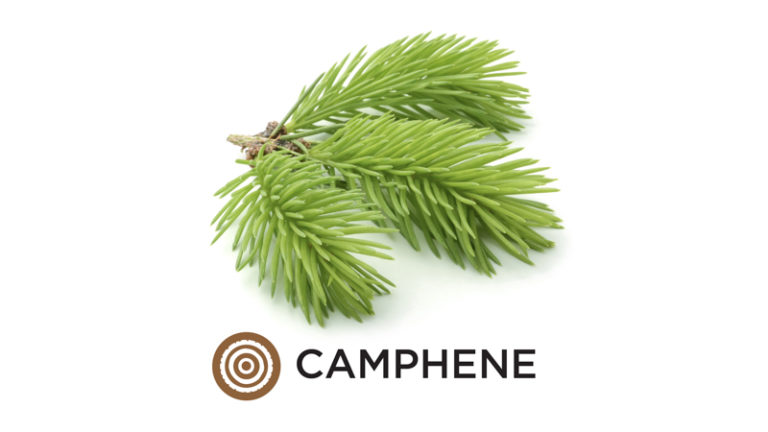 Photo by: Gina Coleman/Weedmaps
Photo by: Gina Coleman/WeedmapsImage lightbox

A terpene found in the cannabis plant, camphene is most known for its pungent aroma and potential therapeutic benefits; studies indicate that camphene may be effective in treating cardiovascular disease and, when mixed with vitamin C, camphene can be a powerful antioxidant that reduces oxidative stress in cells.
What is camphene?
Camphene is a colorless crystal that can be used as a substitute for camphor, as a fragrance or to texturize resins and lacquers. This terpene may also be also used as a food additive to enhance flavors. Essential oils, such as cypress and valerian, may contain trace quantities of camphene. Camphene's historical uses include fuel for lamps in the 19th century. However, due to the terpene's potential flammability, it is no longer used in this capacity. After the mid-19th century, kerosene replaced camphene as the fuel of choice for lamps. But at one time, camphene was the primary source of fuel for lamps and preferred as a cheaper alternative to whale oil.
What does camphene smell like?
The camphene terpene has a damp, pungent, herbal aroma with undertones of pine.
Camphene in everyday life
If you've ever been to a summer party where a citronella candle was burning on the patio, then you have probably encountered camphene without realizing it. Employed as a mosquito repellent, citronella oil contains camphene and has controversial usages as a minor ingredient in bark collars for dogs. The camphene in these collars is said to calm the dogs and discourage barking, but many veterinarians warn against the use of citronella oil with any pet as it may be toxic to them.
Finally, like bisabolol and certain other terpenes, camphene can be a component of skin-care products such as ointments and creams.
Therapeutic benefits of camphene
When combined with vitamin C, camphene may become a powerful antioxidant force capable of naturally treating stress. The terpene has also shown to be useful in treating conditions as diverse as athlete's foot and heart disease.
Additional camphene benefits include:
Antibacterial
One 2010 study evaluated extracts of a few plants that contained camphor and camphene. The research showed that camphene, at least in combination with camphor and other compounds, had antibacterial effectiveness against three types of bacteria. These results suggest that topical cannabis products containing camphene could be beneficial, however, camphene's antibacterial effects have not yet been tested on the human body.
Antifungal
In combination with sage oil, camphene exhibits antifungal potency against such conditions as athlete's foot. When mixed into a paste with tulsi, or holy basil, essential oil, camphene can be applied directly to the skin to treat fungal dermatological diseases including dermatitis.
Antioxidant
Citrus oils including sweet orange and lemon are known for their refreshing scents that invigorate and melt away stress. When combined with citrus oils, camphene has been shown to reduce the oxidative stress that can lead to tissue damage. The holistic Indian system of Ayurveda has known about these effects for millennia. Ayurvedic practitioners tap into camphene-containing juniper berry oil as one of many natural remedies.
Respiratory
Within tulsi essential oil, camphene may be beneficial in battling respiratory illnesses such as bronchitis. In its diluted vapor form, camphene may act as a cough suppressant and anti-congestive tool.
Cardiovascular treatment
Several studies in cells and animals have found camphene acts as a lipid-lowering agent. These findings mean that camphene could treat cardiovascular disease, the leading cause of death worldwide, by lowering “bad” cholesterol, or low-density lipoproteins.
Inflammation
Studies in rodents have shown camphene in combination with other terpenes plays a role in reducing inflammation, a major component of how people experience pain. Pain and inflammation are among the conditions people most frequently cite as reasons for their cannabis use.
Role of camphene in cannabis
In cannabis, camphene exudes an earthy, musky aroma and flavor-enhancing properties. CMedical cannabis containing camphene may aid in general pain relief. In modest amounts, camphene in cannabis can be highly therapeutic in pain management and inflammation reduction. There is also evidence that it can fight melanoma and tumors.
As a growing plant, cannabis uses camphene and other similar terpenes to repel herbivores. On the flipside, the cannabis plant channels terpenes to attract pollinating insects. Camphene, then, is a vital partner to cannabis throughout the plant's whole life cycle.
Bottom line
Once a popular fuel for lamps, camphene is lighting the way in the 21st century as a potential weapon against diverse ailments from mosquito bites to heart disease.
or contributions from Dr. Adie Rae.

